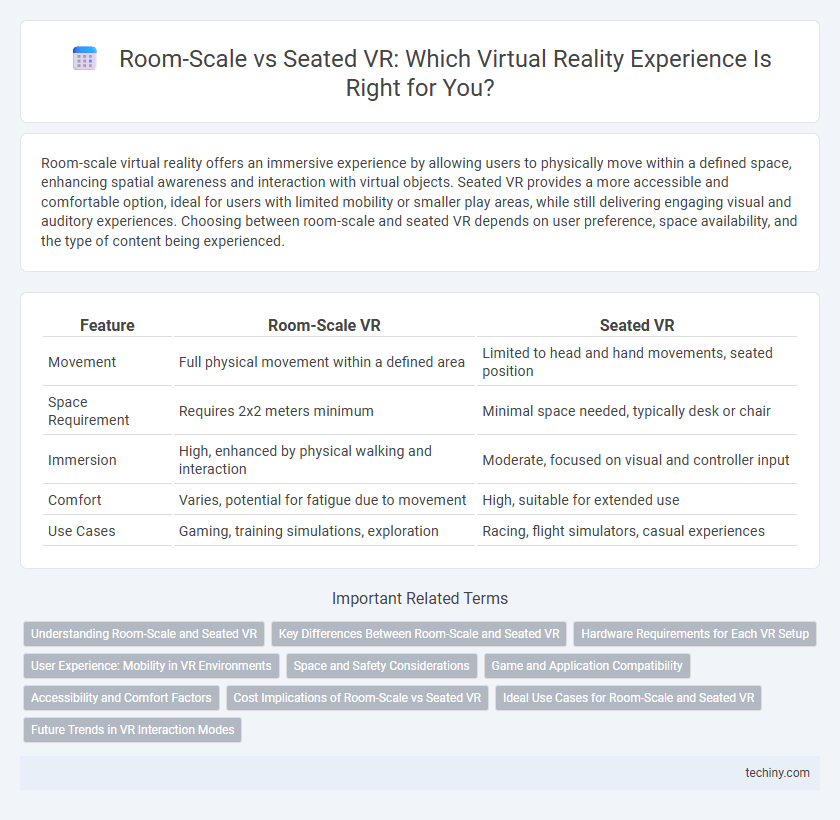Room-scale virtual reality offers an immersive experience by allowing users to physically move within a defined space, enhancing spatial awareness and interaction with virtual objects. Seated VR provides a more accessible and comfortable option, ideal for users with limited mobility or smaller play areas, while still delivering engaging visual and auditory experiences. Choosing between room-scale and seated VR depends on user preference, space availability, and the type of content being experienced.
Table of Comparison
| Feature | Room-Scale VR | Seated VR |
|---|---|---|
| Movement | Full physical movement within a defined area | Limited to head and hand movements, seated position |
| Space Requirement | Requires 2x2 meters minimum | Minimal space needed, typically desk or chair |
| Immersion | High, enhanced by physical walking and interaction | Moderate, focused on visual and controller input |
| Comfort | Varies, potential for fatigue due to movement | High, suitable for extended use |
| Use Cases | Gaming, training simulations, exploration | Racing, flight simulators, casual experiences |
Understanding Room-Scale and Seated VR
Room-scale VR provides an immersive experience by allowing users to physically move within a defined space, enhancing spatial awareness and interaction with virtual environments. Seated VR, on the other hand, offers a stationary experience ideal for limited spaces or applications focused on hand and head tracking without full body movement. Understanding the distinction between room-scale and seated VR helps optimize hardware setup and application design for targeted user engagement and comfort.
Key Differences Between Room-Scale and Seated VR
Room-scale VR offers full-body movement within a defined physical space, enabling immersive experiences that require walking, dodging, and interacting with virtual objects, while seated VR limits user motion to a fixed position, relying on head tracking and hand controllers. The key differences lie in spatial freedom, physical activity, and tracking range, with room-scale systems providing six degrees of freedom (6DoF) for both position and orientation, contrasted with seated VR's often three degrees of freedom (3DoF) focused mainly on head rotation. Performance demands also vary, as room-scale VR requires more advanced sensors and larger play areas to prevent collisions and ensure safety, whereas seated VR prioritizes comfort and accessibility for users with limited mobility or constrained spaces.
Hardware Requirements for Each VR Setup
Room-scale VR demands advanced tracking hardware, including multiple external sensors or base stations, to accurately monitor user movement within a larger physical space. Seated VR setups require fewer tracking devices, often relying on a single sensor or inside-out tracking built into the headset, reducing the need for extensive room calibration. High-performance VR headsets with precise positional tracking and low latency are essential for both setups to ensure immersive and responsive virtual experiences.
User Experience: Mobility in VR Environments
Room-scale VR offers enhanced user mobility by allowing natural movement within a defined physical space, creating a more immersive experience compared to seated VR setups. Seated VR limits mobility, concentrating user interaction within a fixed viewpoint, which may reduce spatial awareness and physical engagement. The increased freedom in room-scale VR improves spatial cognition and interaction realism, significantly elevating overall user experience.
Space and Safety Considerations
Room-scale virtual reality offers greater immersion by allowing users to move freely within a designated physical area, typically requiring a minimum of 6.5 x 6.5 feet to ensure safe navigation and avoid collisions with furniture or walls. Seated VR experiences minimize space requirements and reduce physical risks, making them ideal for smaller environments or users with mobility constraints. Proper sensor placement and clear boundary settings are essential in both setups to prevent accidents and enhance user safety during VR sessions.
Game and Application Compatibility
Room-scale VR offers enhanced immersion by allowing users to physically move within a defined space, increasing compatibility with games designed for full-body interaction and spatial tracking. Seated VR supports a wider range of applications requiring limited movement, such as flight simulators and puzzle games, optimizing compatibility with games prioritizing precision over locomotion. Developers often tailor experiences to the hardware's tracking capabilities, influencing overall game and application compatibility within either room-scale or seated VR setups.
Accessibility and Comfort Factors
Room-scale VR offers greater immersion by allowing physical movement, enhancing accessibility for users with limited mobility through customizable play area boundaries. Seated VR prioritizes comfort by reducing physical strain and is ideal for extended sessions or users prone to motion sickness. Both modalities can be optimized with ergonomic peripherals and adjustable settings to accommodate diverse accessibility needs and maximize comfort.
Cost Implications of Room-Scale vs Seated VR
Room-scale VR requires more expensive hardware such as multiple external sensors or inside-out tracking systems and a larger dedicated play space, increasing setup costs compared to seated VR, which typically uses a single controller and a fixed position. The additional investment in room-scale can lead to higher upfront expenses but offers enhanced immersion and interactivity, potentially justifying the cost for dedicated users and developers. Budget-conscious consumers often prefer seated VR setups for lower entry costs and simpler implementation, especially in confined spaces.
Ideal Use Cases for Room-Scale and Seated VR
Room-scale VR excels in immersive physical experiences, ideal for gaming genres like action, adventure, and fitness that require spatial movement and interaction. Seated VR suits applications such as simulation, training, and narrative-driven experiences where comfort and prolonged use are priorities. Understanding these use cases helps optimize hardware capabilities and user engagement in virtual environments.
Future Trends in VR Interaction Modes
Room-scale VR offers immersive, full-body movement tracking, enhancing spatial awareness and natural interactions, while seated VR prioritizes convenience and accessibility with limited physical movement. Future trends indicate a convergence between these modes, integrating advanced sensors and haptic feedback to enable seamless transitions between seated and room-scale experiences. Emerging technologies like inside-out tracking and AI-driven gesture recognition will further refine interaction modes, providing adaptive and intuitive virtual environments tailored to user preferences.
room-scale vs seated Infographic

 techiny.com
techiny.com